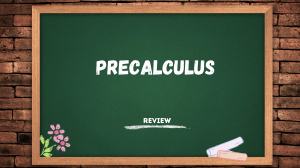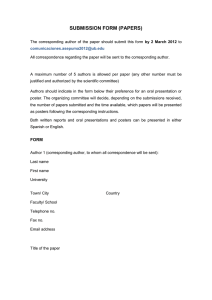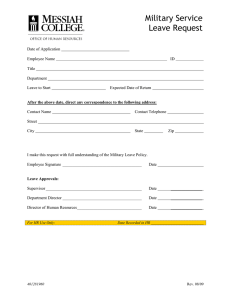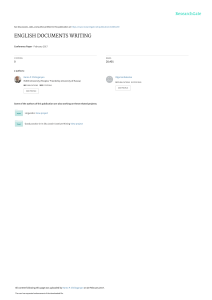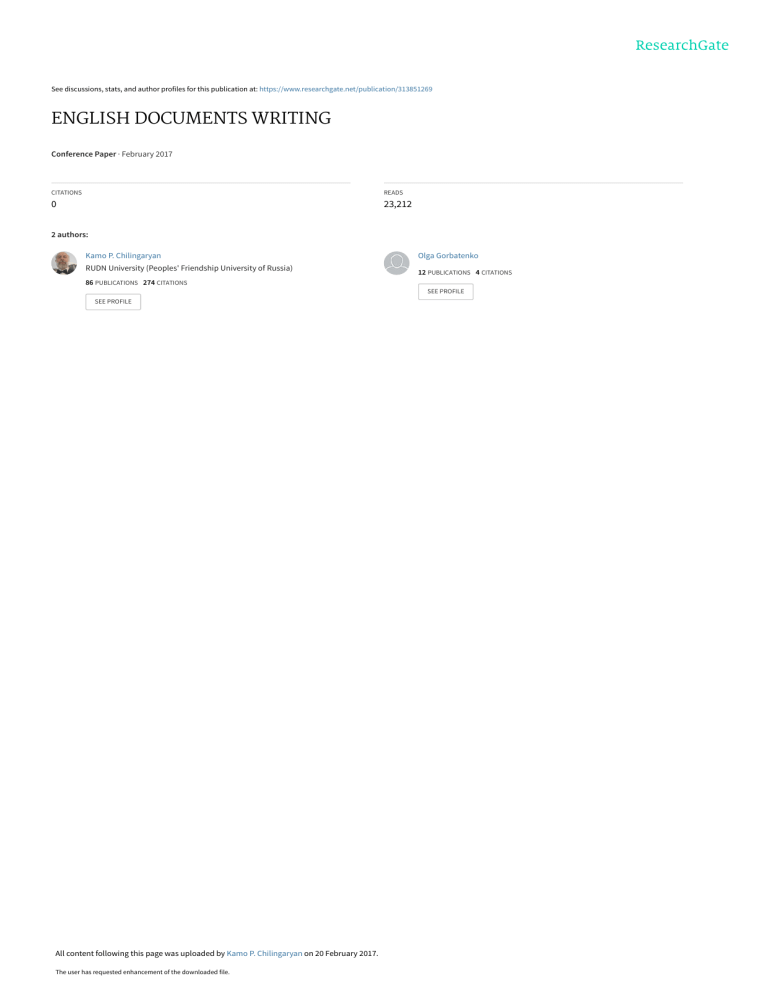
See discussions, stats, and author profiles for this publication at: https://www.researchgate.net/publication/313851269 ENGLISH DOCUMENTS WRITING Conference Paper · February 2017 CITATIONS READS 0 23,212 2 authors: Kamo P. Chilingaryan RUDN University (Peoples' Friendship University of Russia) Olga Gorbatenko 12 PUBLICATIONS 4 CITATIONS 86 PUBLICATIONS 274 CITATIONS SEE PROFILE SEE PROFILE All content following this page was uploaded by Kamo P. Chilingaryan on 20 February 2017. The user has requested enhancement of the downloaded file. Proceedings of INTCESS 2017 4th International Conference on Education and Social Sciences 6-8 February 2017- Istanbul, Turkey ENGLISH DOCUMENTS WRITING Gorbatenko Olga1 and Chilingaryan Kamo2* 1 Assoc. Prof., Peoples’ Friendship University, Russian Federation, vegera2009@yandex.ru 2 Assoc. Prof., Peoples’ Friendship University, Russian Federation, chili1@yandex.ru *Corresponding Author Abstract The issue is dedicated to English documents writing. The work is aimed at analyzing linguistic peculiarities of drafting legal documents. The authors have noticed that while participating at Willem C. Vis annual International Commercial Arbitration moots in Vienna, their students show some difficulties in writing memoranda. Some years ago we were not teaching legal writing. Visiting San Diego University we paid attention to special courses taught there. Now that we organized special courses teaching legal writing, in this work the authors pay attention to business documents such as contracts, legal correspondence, claims, etc., considering that rights and duties must be validated by means of documents. In view of this, judicial documents should be drafted correctly. We truly believe that teaching documents writing now, at university, is a very important issue if we want to bring up comprehendible generation of lawyers. The work lays particular emphasis on the formal business language which is referred to as officialese and differs from other types of the English language, mostly due to specific characters of the functional usage that may be featured in classical terms of style, predetermination and main characteristics. English documents are characterized from both legal and linguistic points of view. The authors draw attention to the functional style of official language which is the defining characteristics of its key components. Official document style presupposes conditions, binding two parties in an undertaking. At the same time business correspondence syntactical pattern style is drawn to reach agreement between them. This is where the authors believe that the importance of the issue under study is in the fact that it could be put into legal practice. The work may also be beneficial for lawyer students, linguists and for all those who work in businesses, for all those who is ready for the modern business challenge. Keywords: Legal writing, Functional style, Legal practice Publisher 1. INTRODUCTION English documents writing has always been part and parcel of business doing. Business contracts can hardly exist without correspondence no matter, whether you conduct an interview with your partner on the phone (orally) or through telexes (in writing). All decisions, terms, rights and duties must be validated by documents. In view of this judicial documents should be drafted correctly. Particular emphasis should be laid on the formal business language. ISBN: 978-605-64453-9-2 363 Proceedings of INTCESS 2017 4th International Conference on Education and Social Sciences 6-8 February 2017- Istanbul, Turkey All business documents, both correspondence (letters), requests, inquiries, massages through telex, written statements (claims) and agreements (contracts) are usually concerned with striking agreements and their standard procedure. All business documents are drawn up and signed by legal authorities and are of special significance [1, p.7]. As a result, business documents are written pursuant to particular forms, common for everyone who wants to do business. The formal business language is also referred to as officialese and differs from other types of the English language, mostly due to specific character of the functional usage that may be featured in classical terms of style, predetermination and main characteristics. 1.1. Styles in question Language functional style is the defining characteristic of its constituents by the greater or less typification of its key components and phrasal units, where the selection and the disposition of interrelated linguistic devices are intended to achieve the goal of interaction [2, p.312]. Official documents style is formed into sub-styles of military documents, diplomacy, the language of business documents and judicial documents. Official documents style presupposes conditions binding two parties in an undertaking and business correspondence syntactical pattern style is drawn to reach agreement between them. The main features of the English documents writing are as follows: 1) standard style of expression; 2) lack of emotions; 3) encrypt nature of the information, including short forms of words and phrases; 4) most common syntactical style of uniting a number of utterances into a single phrase up to structural templates of different forms of the style that have their own patterns. The document form itself is informative, as it gives information dealt with. From the stylistic structure angel, the whole document is one sentence. It looks like separate, shaped clauses often separated by semicolons or commas rather than a full stop. Every predicative phrase starts with a capital letter having the form of a participle or an infinitive phrase. e.g. 3. Claims 3.1. In the event of non-acknowledgment of the goods quality normally supplied by Sellers with the contract specification, any claim pertaining to the quality of the goods may be presented within two months of the date of delivery; 3.2. No claim by Sellers after expiration of the above period; 3.3. No claim presented for one lot of the goods shall be regarded by Buyers as a reason for rejecting any other lot or lots of the goods to be delivered under the present contract. This structurally illogical way of combining definite ideas makes sense. It serves to describe the units equality and similarity between participle and infinitive or predicate phrases. One of the most striking peculiarities of this style is the use of words in their practical dictionary understanding. Thus the contextual meanings or any form of simultaneous implementation of two meanings are ruled out. Emotive words are also excluded [3, p.31]. Every kind of official documents includes its own set phrases and cliché that may seem unusual in every day English, e.g. assets, currency clause, invoice, book value, promissory note, etc. If a person wants to avoid misunderstanding, he / she should use glossary of commercial terms, and vice versa. 1.1.1 Vocabulary Indeed, the vocabulary differs in formal and informal business correspondence. A great deal of vocabulary is borrowed from French, Latin and Greek. They are normally translated into informal language by replacing them with words or phrases of Anglo-Saxon origin. (See the table 1 below). Table 1. Examples of formal and informal styles. Formal style Informal style commence begin, start conclude finish, stop ISBN: 978-605-64453-9-2 364 Proceedings of INTCESS 2017 4th International Conference on Education and Social Sciences 6-8 February 2017- Istanbul, Turkey prolong, continue go on invoke appeal convey carry encounter meet transmit send, pass inquire ask for information conceal hide Spoken English is rich in vocabulary, both standard and slangy. We also have here different connectors, such as well, you see, a kind of which cannot be used in official English, both from logic and stylistic point of view. They are ruled out in terms of logic in view of a small amount of facts they express. Official papers, the other way round, carry a great deal of information in almost any word. Hence, a person should focus on the above in order not to mix up informal and formal English when drafting a document. Informal terms have emotive qualities which are not present in formal documents. Formal documents urge for a great deal of precision. But the problem is that formal and informal English often lack proper equivalents. The informal word job, for example, has no formal equivalent. Instead, we should look for a more restricted in usage and a more precise word, depending on the context, among possible substitutes: post (esp. BrE), appointment, vocation, employment, position, etc. [4, p.12 – 13] Business English is formal. We use it in business correspondence, official reports and regulations. 1.1.2 Formality in speech Normally, it is always in written form. It is used in speech exceptionally, for example, in formal public speeches. There are different levels of formality: “After her mother’s death, she had to change her work” (informal). “On her mother’s disease she felt obliged to seek for alternative position”. (formal). These sentences have almost the same meaning, but would emerge in different events. Sentence 1 carries rather neutral (common core) style, while sentence 2 is very formal, in fact inflated, and would only occur in a business document. Generally speaking, the rules of English grammar of spoken language are rather simple and less complicated than those of written language, particularly in terms of contracts. It is rather hard to divide spoken English into different sentences as connections between clauses are obscure because the interlocutor relies more on the listener’s understanding of the contextual information and also on his/her natural ability to interrupt if he/she does not have a clear understanding. The interlocutor is able to rely on the specifics of intonation that tells us it cannot be reflected in written punctuation. The use of grammar in business correspondence also differs in terms of pronouns whom and who and the place of prepositions: “He needed a business partner in whom he could confide”. (formal). “He longed for a business partner (who) he could confide in”. (informal) “In what country were they born?”. (formal). “What country were they born in?”. (informal) 2 FORMAL WRITTEN LANGUAGE Formal written language normally carries impersonal style. That implies that one doesn’t refer directly to himself / herself or to his / her readers, but avoids pronouns. Some of the common characteristics of impersonal language are passive sentences beginning with the introductory word it and abstract nouns. The importance of the change into a passive construction is to shift the focus from the subject to the object of speech. Abstract nouns, especially amount words (majority, minority, amount), define more precisely the meaning of an utterance. As an example see an announcement from the librarian. ISBN: 978-605-64453-9-2 365 Proceedings of INTCESS 2017 4th International Conference on Education and Social Sciences 6-8 February 2017- Istanbul, Turkey “It has been noted with concern that the stock of books in the library has been declining alarmingly. Students are asked to remind themselves of the rules for the borrowing and return of books, and to bear in mind the needs of other students. Penalties for overdue books will in the future be strictly enforced”. It would be a very formal and impersonal message which could have been made in a more informal and less impersonal way, achieved by usage of phrasal verbs, contractions, colloquial phrases and other linguistic tools: Compare the librarian’s message with the announcement: “The number of books in the library has been going down. Please make sure you know the rules for borrowing, and don’t forget that the library is for everyone’s convenience. So from now on, we’re going to enforce the rules strictly. You have been warned!” It would be more polite to avoid offence or distress in correspondence. As a matter of fact it is disguising to cover up the truth. In this situation, the use of imperatives should be polite: e.g. “Would you like to stipulate details of the contract?” Let us compare some more examples: “I suggest that we postpone signing of the contract till tomorrow” (tactful). “Could we postpone signing of the contract till tomorrow?” (not confident and more tactful). Could is not connected with tact, but is simply an indication of the speaker’s reluctance to commit himself / herself on a given question. To use might is characteristic of business correspondence, as it is a more definite way of expressing possibility than may. 2.1 Examplifying Let us compare two sentences: 1. “There may be an error in a contract”. 2. “There might be an error in a contract”. In sentence 2 might suggests a doubt to a greater extend and seems more tactful than may. Business documents are specific and aimed at a definite purpose. In order to make one’s business work and work effectively, a person should have a good command of language standards in business letters. Skilful application of the knowledge is somehow defined by standards of documents’ writing. If a document is written in an acceptable way, it will be duly assessed by specialists. A joint business document absorbs less time and work as compared to private correspondence. So far as writer of a business letter has a unified form in front of him / her, that person keeps to a set pattern while doing it. The writer’s attention is focused on major information and data that represent the subject of the document. In this way, an addressee can decode the subject-matter much faster, because a document is written in the standard form. Thus, if business documents are drawn up in a unified and, to some extent, simplified way, it costs less money and saves time for the parties, and shortens the time of business procedure as well. A special branch of English linguistics is business English, devoted to the purpose of simplifying business procedure. Written business English presupposes certain traits and problems of its usage not only for foreigners, but for English-speaking business people. To draw up business correspondence is equal to communicating with people in a business-like manner [5, p.4]. A person should know the rules of documents’ writing to make one’s business effective and profitable. All of them are united under the concept of style. 2.1.1 Language tools A language style is a system of interdependent language tools that pursue a particular communication goal. As mentioned above, the style can be formal (business written English) and informal (spoken English). The difference of formal and informal English is a matter of style and attitude of people towards one another. Nevertheless, it is not so easy to draw an exact line between informal and formal English, and that is the most important thing to be identified in this paper. English documents’ writing has some important characteristics, common for formal English style. The language of business English is very bookish and is unusual to use more precise terms, as compared to the informal style of interaction. Sentences in documents are normally long and the clauses fit together more thoroughly in terms of grammar which implies a great deal of practice for a person who drafts a contract. It is generally expected that genuine business people, experts in their field, should enjoy the preciseness in grammatical construction. It does not mean, of course, that business people should communicate in formal business style. Formal business correspondence should be more impersonal. It should not emphasize the individuality of the writer, and takes little account of the personal qualities of people who are going to make use of it. ISBN: 978-605-64453-9-2 366 Proceedings of INTCESS 2017 4th International Conference on Education and Social Sciences 6-8 February 2017- Istanbul, Turkey Furthermore, the speaker should not refer directly to himself or his readers, but avoid the pronouns I, we, you, and it may also present some difficulty for a person. One more feature is that formal language lacks strength and brightness. Formal language suggests that it depends a lot on its arbitrary conventions, rather than on colloquial speech. That is why it is so difficult for non-business people to keep concentrating their attention on contents of documents all the time, as their attention is distracted by intricate language use. Some of them will find their long and complicated sentences rather confusing. The lexicon of formal English may sound correct, but its meaning is often complicated to understand. 2.1.2 Business correspondence Normally a person should read the text once and again to understand what it means. “This conditionality being of the core of the contract, default by the buyers shall entitle the sellers to load and ship the goods to any convenient port mentioned in the contract and the clients shall receive them accordingly”. (Extract from a standard form of contract for the sale of timber through broker in the U.K.) [6, P.229] Another significant problem regarding business correspondence is that it will be read by businessmen who normally are not interested in their personality. Taking into consideration the fact that one should not waste anyone’s time and make a particular impression on the employers, a person applies formal language to avoid useless information concerning matters handled, replacing them with standard routine. Clearness and briefness is a general characteristic of any business document, e.g. “The delivery time for the Shek Company against the above contract expires on the 14of May. Please notify us by return of post of the Shek goods progress”. However, in some essential business correspondence we may come across deviations from what is called formal business world language. For example, if individual applies for a job or signs an agreement or asks someone for advice, he / she is likely to make a particular impression on the listener, e.g.: “I spent my green years first in Italy that made a great impression on me (they say I look like and Italian, joke), then we moved to live in the Far East where I played hockey, went to the Secondary School and was madly in love with British hard rock music”. [7, p.35] A person applied for a particular job and tried to show his/her writing skills. It does not imply, however, that a person in charge will be much interested in his/her personality. If he/she starts business correspondents on a particular matter the first thing for him/he to consider it thoroughly and go on doing business in the same way. There are some important problems in the theory of business correspondence that may concern a person who is likely to get involved in a business undertaking. 3 DISCUSSION AND CONCLUSION To correct writing English texts is not enough knowledge of vocabulary and grammar. At best, they allow the writer to formulate a thought, without violating the rules of grammar. We believe that it is necessary to follow the rules of writing documents: the rules of text design, construction of sentences and the use of vocabulary. The writer of a legal document should ideally look up words, syntax, and text to look right for a native speaker. Selecting terms, syntax constructions, enhance the level of understanding the text as a whole. Study of syntax, terms, semantics, morphology also provide for the overall level of language. The authors suggest using the active rather than passive voice in the English documentation. Business language differs considerably from private correspondence. A collective business document takes less time in comparison with private correspondence. In view of this the authors put a focus on business correspondence syntactical pattern style which may help to reach adequate agreement between parties. The functional usage of the legalese which differs from general English language would make it easier to better understand the idea of any document, an agreement in particular. Much attention should be drawn to active construction in order to shift the focus from the object to the subject of the agreement. The authors believe that the focus on the subject of the agreement will help to avoid substantial mistakes when doing business and drafting legal documents. The knowledge of business and judicial documents structure as well as the language of diplomacy are of crucial importance for drafting judicial documents properly. ISBN: 978-605-64453-9-2 367 Proceedings of INTCESS 2017 4th International Conference on Education and Social Sciences 6-8 February 2017- Istanbul, Turkey REFERENCE LIST [1] Berman, A. (1984). L'Epreuve de l'etranger: Culture et la Traduction dans l'Allemagne romantique, Paris: Gallimard. [2] Bassnett, S. and A. Lefevere. (1990). Translation, History and Culture, London and New York: Printer. [3] Berman, A. (1995). Pour une critique des traductions: John Donne, Paris: Gallimard. [4] Hatim, B. and I. Mason. (1997). The translator as Communicator. London and New York: Routeledge. [5] Brower, R. (ed.) (1955). On Translation, Cambridge, MA: Harvard University Press. [6] Catford, J.C. (1965). A Linguistic Theory of Translation. London: Oxford University Press. [7] Benjamin, W. (1968). The Task of the Translator, in Illuminations, ed. H. Arendt, trans. Harry Zohn, New York: Schocken, pp.69-82. ISBN: 978-605-64453-9-2 View publication stats 368
